HYBRIDS, FUEL CELLS AND ELECTRIC CARS IN JAPAN
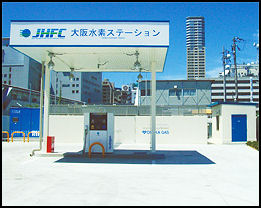
hydrogen station in Osaka In 2008, all ten of the most fuel efficient vehicles in the United States were Japanese cars. They were the 1) Toyota Prius (46. 65 miles per gallon); 2) Honda Civic hybrid (42.25 miles per gallon); 3) Nissan Altima hybrid (34.1 miles per gallon); 4) Toyota Camry hybrid (33.45 miles per gallon); 5) Mazda-made Ford Escape, Mercury Mariner and Mazda Tribute (32.2 miles per gallon); 6) Toyota Yaris (32.15 miles per gallon); 7) Toyota Corolla (32 miles per gallon); 8) Honda Fit (30.7 miles per gallon); 9) Honda Civic (29.8 miles per gallon); 10) Nissan Versa (28.25 miles per gallon)
The Japanese government has said that it wants 50 percent of new cars sold to be eco-friendly models such as hybrids or electric cars by 2020, up from the current nine percent. It has also said it wants to have 2 million chargers installed in ordinary households by that time. It estimated the prices of lithium batteries should fall by one seventh of their 2006 prices by 2015 and one fortieth by 2030.
In September 2010, new regulations, the strictest in the world, on permissible exhaust levels in new vehicles went into effect. The sales of diesel cars in Japan began around the same time in part because they have an easier time meeting the new regulations on permissible exhaust levels. Diesel vehicles use cheaper light oil as fuel, and are more than 20 percent more fuel efficient and produce less greenhouse gases than gasoline-powered cars. They have been popular in Europe for some time. Mitsubishi and Nissan were the first to release diesel vehicles the SUVs Mitsubishi Pajero and Nissan X-Trail.
To improve gas mileage researchers are experimenting with turbo charging and direct injection. Such technologies can be used to get more power and more mileage out of relatively small engines. These technologies are expensive but make more sense as gasoline prices rise.
Liquified petroleum gas is widely used in Japanese taxis. Japanese automakers are developing clean diesel engines. Diesel has long had a bad reputation because it produces dirty, black exhaust but these days advancements have made diesel fuel more efficient and cleaner-burning that gasoline engines. In addition, diesel fuel is cheaper and widely used in Europe.
In 2009, the Japanese government introduced tax breaks and subsidies for people who bought fuel-efficient cars under a policy similar to the “cash for clunkers” program offered in the United States. While Japanese companies claim to be leaders in “green technology for cars. They are also leading makers of gas guzzling SUVs.
Japanese companies are also working on cars that are totally recyclable.
Websites and Resources
Good Websites and Sources: Wikipedia article on Hybrids Wikipedia ; Toyota Hybrids toyota.com/hybrid ;Honda Hybrids honda.com/Hybrid ; Nissan Hybrids http://www.nissanusa.com/altima ; Wikipedia article on Fuel Cells Wikipedia ; Honda Fuel Cells honda.com/FuelCell ; Wikipedia article on Electric Cars Wikipedia ; All Electric Cars Blog allcarselectric.com ; Mitsubishi Electric Cars mitsubishi-cars ;Toyota Electric Cars allcarselectric.com/blog ;Nissan Electric Cars nissanusa.com/leaf-electric-car ;
Links in this Website: BICYCLES AND MOTORCYCLES IN JAPAN Factsanddetails.com/Japan ; URBAN TRANSPORTATION IN JAPAN Factsanddetails.com/Japan ; TRAINS IN JAPAN Factsanddetails.com/Japan ; SHINKANSEN (JAPANESE BULLET TRAINS) Factsanddetails.com/Japan ; AUTOMOBILES AND DRIVING IN JAPAN Factsanddetails.com/Japan ; AUTOMOBILES ACCIDENTS IN JAPAN Factsanddetails.com/Japan ; HYBRIDS, FUEL CELLS AND ELECTRIC CARS IN JAPAN Factsanddetails.com/Japan ; JAPANESE AUTOMOBILE INDUSTRY Factsanddetails.com/Japan ; JAPANESE AUTOMOBILE COMPANIES Factsanddetails.com/Japan ; TOYOTA Factsanddetails.com/Japan ; TOYOTA PRODUCTION AND WORKERS Factsanddetails.com/Japan ; TOYOTA PROBLEMS Factsanddetails.com/Japan ;TOYOTA CARS, RACING AND ROBOTS Factsanddetails.com/Japan ;HONDA Factsanddetails.com/Japan ;HONDA CARS, PLANES, ROBOTS AND RACING Factsanddetails.com/Japan ;NISSAN Factsanddetails.com/Japan ;AIR TRAVEL AND AIRLINES IN JAPAN Factsanddetails.com/Japan ; SHIPPING AND BOAT TRAVEL IN JAPAN Factsanddetails.com/Japan ; INFRASTRUCTURE AND PUBLIC WORKS IN JAPAN Factsanddetails.com/Japan
Good Websites and Sources on Transportation: Good Photos at Japan-Photo Archive japan-photo.de and japan-photo.de ; Ministry of Land, Infrastructure, Transport and Tourism mlit.go.jp ; Statistical Handbook of Japan Transport Chapter stat.go.jp/english/data/handbook ; 2010 Edition stat.go.jp/english/data/nenkan ; News stat.go.jp
Japanese Eco-Cars and Trucks
The Pod, a "smart car" developed by Toyota and Sony, interprets a driver’s preferences from information stored in a palm-sized key that can be connected to a personal computer or television set when the car is not in use in order update information. Among other things the car can select music the driver likes.
A solar power vehicle developed by Honda that looked like an alien spacecraft with wheels won the forth World Solar Xhallenge in 1996 by traveling more than 3,000 kilometers across the Australian desert at an average speed of 90 kilometers per hour using only solar power. A one passenger solar car produced by Tokai University won the 2009 Global Green Challenge in Australia. Driven by former Dakar Rally champion Kenjiro Shinozuka, the car averaged 100.4 kph.
Japanese truck makers are also developing fuel-efficient, environmentally-friendly vehicles. Hino has developed a hybrid trucks. Isuzu have developed a plug-in hybrid trucks Hino, Isuzu, and Fuso have all rolled out eco-friendly heavy-duty trucks that sell for between ¥16 million and ¥21 million and have things like exhaust emission control and diesel engines that produce less nitrogen oxide and particulate emissions. An impetus for the innovation a been September 2010 emission standards.
In October 2011, a stand exclusively for electric and hybrid taxis opened near JR Tokyo Station as part of a campaign led mainly by the government and the taxi industry to promote "eco-friendly" means of transportation. A similar taxi stand was opened at JR Osaka Station the previous May.
Hybrid Cars
Hybrid cars are cars that have two power systems: an electric motor powered by a nickel-metal hydride batteries and a highly efficiency gas engines. Electricity is generated by the car so there is no need to plug it in. Hybrids are viewed as bridges until technologies of the future are ready.
Hybrid cars use electricity for starting up, idling and driving slowly. The gasoline engine kicks in when more power is needed. At high speed gasoline is the primary power source, with electricity providing a boost. Computers regulate the two power systems. During coasting or braking, the wheels drive the electric motor, which recharges its batteries. When the car idles, the engine cuts off, saving gas and reducing emissions.
Hybrids get about 10 to 30 percent of their power from the electricity. The remainder comes from gasoline. In this respect there are just improved regular vehicles. They routinely get 60 miles per gallon and can travel 600 miles on a single tank of gasoline.
Hybrids are currently selling better than alternative fuel vehicles in part because they run on readily-available gasoline; securing fuel for the alternative fuel vehicles is more problematic. Toyota and Honda use nickel-hydrogen batteries in their hybrids. Nissan uses lithium-ion ones which have a larger capacity and can be recharged more frequently.
High oil price increased demand for hybrids.Hybrids and economy class vehicles made by Toyota and Honda dominate the list of fuel-efficient vehicles in the United States, holding seven of the top 12 listed vehicles in 2006. At the top of the list is Toyota’s Prius with 3.9 liters per 100 kilometers in the city and 4.6 liters on the highway. In second is the Honda Civic Hybrid with 4.8 liters per 100 kilometers in the city and 4.6 liters on the highway.
Robust sales of the Toyota Prius and Honda Insight — the top and 8th top selling cars respectively in Japan in 2009'show that hybrids have entered the mainstream. Sales of hybrids was helped by tax breaks and subsidies for fuel-friendly vehicles. The total sales of hybrids in Japan in 2009 was 347,729 vehicles, a hike of 240,000 units from the previous year.
News hybrids and electric cars are being rolled out at quicker and quicker pace. Suzuki plans to offer a plug-in hybrid that can be plugged in at home. MMC has said it plans to sell a plug-in hybrid in 2012. The vehicle would get about 50 kilometers per liter (120 miles per gallon), making it the most fuel efficient vehicle available.
Hybrid Problems
Hybrid technology adds an additional $5,000 to the sales price of a car. The Japanese government offers car buyers $2,500 in tax credits if they purchase a hybrid car. Car companies don’t make any money from hybrids. They only will make money if they are subsidized by the government somehow or enough of them are sold to create an economy of scale.
“Some people who come in and want a hybrid, say they want it for the fuel economy,” a sales representative at a Chicago Honda dealer told Bloomberg News. “But the hybrids cost more, so it may take five years for somebody who doesn’t drive much to see a cost benefit.” In such cases, the customer would be steered toward a Civic, the representative said.
Hybrids and electric cars are so quiet at low speeds they present a danger. In one test 40 visually impaired people were told to raise their hands if they heard anything when a hybrid approached at a low speed. When the hybrid approached only a few raised their hands. When a normal vehicle approached all of them raised their hands. At higher speed electric cars more noise, mostly from the tires.
A plan has been adopted to have hybrids and electric cars make some noise. In most cases the vehicles will be have artificial noise making devices that will make noises like conventional automobiles. Nissan is consulting with composers to give their cars “beautiful and futuristic” sounds.
Toyota Hybrid Cars
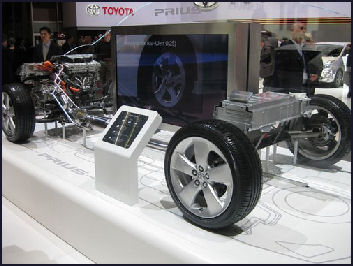
Toyota hybrid drive train Toyota is regarded as the leader in hybrid technology. It has a number of key patents and is already into the second generation of hybrid vehicles. Many other companies use Toyota technology.
Toyota hybrid sales topped the 1 million mark in the United States in March 2009. Toyota sold 140,000 hybrids worldwide between 1997 and 2003. It sold over 300,000 hybrids in 2006. At total of 241, 405 were sold in 2008 during the global recession. Toyota hopes to sell 1 million a year worldwide by 2010.
Toyota is a leader in plug-in hybrids — hybrids that can be plugged into a normal wall socket. The extra electricity allows the car to rely more on electric power and use less gasoline especially on short trips and running errands near the home. A plug-in hybrid with a lithium-ion battery is planned to be introduced in 2009. Toyota is experimenting with a plug-in Prius that can be turned around and used as generator to power a house in the event the electricity goes out. It can provide electric energy equivalent to gasoline at the price of $1 per gallon.
Toyota is experimenting with solar powered electricity generating system with the goal of producing cars that don’t need outside energy sources. It is also investing heavily in next-generation batteries that will far outperform lithium-ion batteries currently used in hybrids on the market.
Toyota has said that it will begin leasing plug-in hybrids by the end of 2009 in Japan, Europe and the United States. These vehicles have lithium ion batteries rather than the nickel-metal hydrid batteries used on the Priuses.
Prius
The Toyota Prius is a five-seat, gas-electric hybrid. It has a base price of $23,000and gets 30 percent of is power from electricity and gets 60 miles per gallon in the city and 45 on the highway. In 2008, it was was named the most fuel efficient car for the third consecutive year, getting 35.5kilometers per liter. Prius is Latin for "to go before."
As of March 2011, Toyota had sold 3 million hybrids worldwide since 1997.Of the 7.53 million vehicles the company sold in 2010, 690,000 were hybrids. In December 2010, Prius was the best-selling car in Japan for the 18th consecutive month. In October 2010, Prius sales reached the 1 million unit mark worldwide. The Prius was the top selling car in Japan for the first time in May 2009. It was the best-selling car in Japan in 2009, selling 201,528 units, around 22,000 units a month, an 186 percent increase from the previous year. It was voted Car of the Year in October 2009 at the Tokyo Motor Show.
The Prius was introduced in Japan in 1998 and launched in the United States in 2000. The first 12,000 Priuses were put on the market quickly sold out but sales stalled after that. The car was launched at a time when gas was cheap and SUVs were popular and didn’t really take off until 2003, when a redesigned Prius was launched.
The sale of Prius rose from 18,000 in 1998 to 100,000 in 2002 to 312,000 in 2006. In 2006, it accounted for 40 percent of hybrid sales in the United States. The one million mark was surpassed in May 2007. At that time 1.047 million Priuses’s had been sold, with 345,000 sold in Japan and 702,000 sold overseas. Grants of $3,500 was given to early Prius buyers in the United States.
The Prius is popular with car critics in the United States. In 2004 the Prius was selected as the North American Car of the Year at the North American International Auto Show in Detroit. The following year celebrities were shown arriving in Priuses at the Academy Awards. Among those who drive the car are Leonard DiCaprio, Cameron Diaz, Paul Newman, Natalie Portman, Merlyn Streep, Ted Danson, the founders of Google and Republican country sheriffs who want to reduce America’s dependence on Middle Eastern oil.
Jerry Garret wrote in the New York Times, “Not only did the Prius help to prove that hybrid gas-electric powertrains can be feasible reliable and desirable, the car has become the object of cultlike affection and a social statement.” Toyota says that 80 percent of Prius owners would buy another.
The success of Prius has been attribute to experience in the market and improvements made from by buyer feed back Toyota’s Jim Press told Newsweek, “Ten years go people tried the Prius because it was a Toyota. Today, people are buying Toyotas because we have the Prius.”
Still, the Prius doesn’t make money for Toyota because it’s complicated and costly propulsion system. It costs about $2,000 or $3,000 more than comparable regular models The maintenance costs for the Prius are high and resale value is low. The cost of replacing power pack is $3,400 compared to $1,900 for a new engine in a conventional car.
Until 2004 the Prius was built only in Japan. Toyota is now making hybrid SUVs and Priuses at its Texas plant and in China.
New Prius

2010 Prius The new 2010 Prius was introduced in the spring of 2009. Slightly bigger and slightly faster than previous models, it gets 50 miles per gallon (21 kilometers per liter), with 51 mpg in the city and 49 on the highway, . The starting price was around $20,000, $3,000 cheaper than the old model. The lower price came in part as response to the Honda Insight hybrid, which sells for $19,000.
In his 34-mile test drive of the 2010 Prius in stop-and-go traffic, averaging 27 mph, Garret said he got 60 mpg and a friend taking the same route got 74 mpg. Garret said he got his best mileage “when my move on and off the accelerator was like a teenager on his first day of driver’s ed.” The pulse-and- glide technique “consists of goosing the gas pedal for about 10 seconds to bring up the speed and torque efficiency of the gasoline engine, then gliding with foot off the accelerator for a few seconds to bring in th maximum benefit form the electric motors. You can always monitor the effect of this by watching the “instantaneous fuel consumption meter” and the new “hybrid system indicator” graph on the information-laden dashboard display.
The new Prius offers three performance modes: EV fo electric only, ECO for economy and POWER for power. In the EV mode its possible to travel up to a mile at 24 mph or less, on battery power alone. But that discharges the battery and it takes 20 to 30 miles of driving to recharge it.
Third-generation Prius come with an electronic humming device that produces a whirring noise about the same noise level as a regular car, enough to alert people that a vehicle is nearby without producing an annoying sound. The $140 device was made available in Japan in August 2010.
In 2011, Toyota introduced a Prius station wagon and minivan in Japan and a Prius plug in the United States as part of its plan to offer Prius as a family of cars. The three-row, seven-seat minivan has a lithium-ion battery and starts at around $35,000. The plug in gets 48 kilometers per charge. In November 2010, the company said it would unveil 11 new hybrids by the end 2012.
Other Toyota Hybrid Models

Lexus hybrid Toyota is the largest producer of hybrid vehicles. As of 2008, Toyota sold six hybrid models in the United States, including the Prius sedan, the Estima minivan, and the Crown luxury car, the Highlander SUV, a hybrid version of the Lexus RX 330 SUV, a hybrid Camry and hybrid Lexus LS 600, which sells for $140,000.
Some hybrids like the Prius are tuned for maximum gas mileage. Others like the Lexus are tuned for performance with hybrid technology providing a small boost in gas mileage. In the mid and late 2000s when oil prices were reaching all time highs Toyota said that it might switch all of its vehicles over to hybrid engines,
A Toyota hybrid — the HV-R — won a 24-hour endurance care in Hokkaido. The car was able to draw a surprising amount of energy from the car’s acceleration and braking Toyota hope so race the same car in Le Man.
Sales of the RX4 — hybrid SUV reached 85,000 world wide between 2005 and 2006. Another hybrid SUV, the Highlander, sold 67,000 over the same time period.
Toyota is now aiming to improve the “wow” factor of its hybrids. A model planed for introduction in 2009 has a button that allows drivers to run solely on battery power for a few miles before the energy supply is used up and the gas engines kicks in again. The FT-HS is concept car with hybrid technology, 0-to-60 in four seconds accelerating and gas mileage like that of Celica, The aim to get the cost down to around $35,000.
In one test, a Toyota fuel-cell hybrid was able to go 480 kilometers on a single tank if hydrogen, Toyota is also experimenting with carbon fibers and other materials t make its vehicles lighter. One experimental vehicle, the 1/X plug-in hybrid made with such material, weighs one third less than a Prius and get double the Prius’s gas mileage,
Toyota has said that it hopes to begin selling a plug-in hybrid in 2011. The vehicle will likely cost $30,000 or more. Toyota plans to introduce an “ultra-fuel-efficient” hybrid as early as 2010 that gets 40 kilometers per liter and costs less than $15,000. The design is based in the Vitz minicar.
Toyota introduced its first hybrid-only Lexus model — the HS250h — in July 2005. Starting at about $40,000, it was launched with a promotion featured Miss Universe 2007 — Japan’s Ryo Mori — and Miss Universe 2006 first runner-up — Kurara Chibana, also from Japan.In October 2009, Toyota unveiled the Sai hybrid luxury sedan, part of its expanded range of hybrids, The Sai gets 23 kilometers per liter, and is roomier, has a bigger engine and more features than other Toyota hybrids.
Toyota has said that it hopes to begin commercial production of electric vehicles by 2012. In August 2009, Toyota said that it would purchase lithium ion batteries from Sanyo for its hybrids, citing that the technology of the batteries was “high.”
Honda Hybrids

Honda Insight While Honda has had success with its small cars it admits it has fallen behind Toyota with hybrid vehicles. Honda was the first to sell hybrids in the United States but its hybrids looked like its regular cars and sales never took off as they did for the more distinctive Prius. As of 2007 Priuses were outselling hybrid Civics and Accords five to one. Honda canceled the hybrid Accord because it failed to attract buyers.
The Honda Insight is a two-seat, gas-electric hybrid that gets 600 miles on a single, tiny tank of gasoline. Introduced in December 1999, it has a base price of $19,995 and got 61 miles per gallon in the city and 70 on the highway. The Insight drives mostly on gasoline with small electric boost. It gets much of fuel economy from a lightweight, aerodynamic aluminum body. Honda pulled the Insight in 2006.
One of Honda’s strategies is to offer low-cost hybrids. A new Insight is billed at the cheapest hybrid on the market. Marketing using an ad with George Clooney, it sells for about $19,800 in the United States, about 15 percent lower than the Prius. It made its sales room debut in Japan in February 2009 and made the top ten list in sales. In April it was the top-selling car in Japan. In May it fell to third. The car has also sold well in the United States
The Insights gets fuel milage of 43 miles per gallon, compared to 45 for the Prius. It shares parts with other Honda vehicles which has helped keep its price down. It has been purposely designed with a triangular Prius-like shape.
In 2009, Honda plans to introduce a five-passenger, small hybrid, code-named “Global Small Hybrid” that sells for $22,000 and has the best milage of any car. Cheaper than the Prius and aimed at young buyers, Honda hopes to sell 100,000 of these cars a year. Later Honda plans to introduce a sporty hybrid and hybrid version fo the Fit. Honda expect hybrids to account for 10 percent of sales by 2010.
Hybrid technology adds an additional $5,000 to the sales price of a car. Honda wants to reduce the cost to $2,000. Honda is designing motorscooters with hybrid engines. Honda get its batteries from Sanyo and Panasonic. It has invested heavily in batteries and has a deal with battery-maker GS Yuasa to produce lithium-ion batteries.
Honda’s Insight has been selling better than expected, the company plans to introduce a hybrid Fit soon. Suzuki may sell hybrid cars in North American from 2011. In a 2009 investment report Mazda said that it was giving top priority to the development of hybrids. Luxury hybrids such as the $40,000 Lexus HS250h are selling quite well.
In February 2010, Honda launched the world’s first hybrid sports car: the two-seat CR-Z, with a price tag of around $23,000. It was unveiled at the Tokyo Auto show in 2009 along a six-seat hybrid (Skydeck) and a small urban-use electric car (the EV-N). In October 2010, Honda introduced a hybrid Fit that sells for ¥1.59 million, making it the cheapest hybrid in Japan. Honda has plan to begin selling an electric car and plug in hybrid in 2012.
Fuel Cell Cars

Honda fuel cell engines A fuel cell car is essentially a car with a miniature electric-power generator that is powered by a combination of hydrogen and oxygen. It is cleaner than internal combustion engine care because it is generated by a chemical reaction not the burning of fuel. Unlike electric cars, you don’t need to recharge a battery. Many believe that fuel cells are the car technology of the future. There are plans to have 50,000 fuel cell vehicles on the roads in 2010 and 2 million in 2020.
Fuel-cell vehicles are very expensive to produce. In the early 2000s, the costs were estimated to be about $1 million per unit but costs have been lowered by reducing the amount of platinum and other precious metals used in parts and electricity generation. Honda, Toyota and DaimlerChrysler are in competition to produce the industry standard. It is widely believed that whoever can create the fuel cell technology standard will be the future leaders in the automobile industry.
Fuel cell vehicles make virtually no noise except for a whirring sound. They run cool. The only emission is water that emerges from the tailpipe clean enough, they say, to drink. It doesn’t need to be plugged in. It can serve as a source of energy to light up a home, for example. Its fuel source, hydrogen, is virtually inexhaustible.
Most fuel cell vehicles run on compressed hydrogen. Hydrogen is the most abundant element in the universe but is difficult to find in a pure form because it is mostly locked into chemical compounds like water. Hydrogen can also be created by splitting the water molecule but that takes more energy than the hydrogen will produce in the fuel cell.
Most fuel cell vehicles run on a source of compressed hydrogen which is made in factory from natural gas or from methanol or gasoline. Daimler produced vehicles that produce hydrogen from methanol. They can travel 259 miles on 10 gallons of methanol. Scientists are experimenting with a number of ideas, including harvesting hydrogen from pond scum.
For fuel cell cars to be practical you need stations that provide hydrogen cell. To create a network of these stations across the United States alone and the infrastructure to support it requires a minimum of $16 billion according to a study by Shell Hydrogen.
Fuel Cell Technology
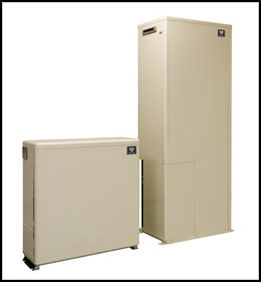
home fuel cells Electrochemical fuel cells run on hydrogen that is fed into fuel cells that react with atmospheric oxygen to produce electricity which powers the vehicle. The fuel cell consist of a negative electrode and positive electrode with proton exchange membrane in between. The combination of hydrogen and oxygen produces water and electricity that runs the car. There is no burning and its only emission is water.
Fuel cells were invented in 1839 by Sir William Grove, a Welsh judge and gentleman scientist and friend of pioneering physicist Michael Faraday. The technology never caught on because of the success of the internal combustion engine and was largely forgotten until it was resurrected in the 1960s to provide energy for Gemini spacecraft, using of materials like Teflon and platinum.
Fuel cell vehicles have: 1) a large barrel-size tank for storing hydrogen in the trunk area that keeps liquid hydrogen supercooled at -253̊C; 2) a stack of fuel cells under the passenger seat; 3) a battery that stores electricity for when bursts of power are needed; 4) an integrated power train near the wheels comprised of a motor which takes power from the fuel cells and uses it to spin the wheels; and 5) regenerative brakes which convert energy from braking back into electricity which is stored in the battery.
All this stuff is heavy. Fuel cell cars weigh about 600 pounds more than regular vehicles and accelerate much slower. Currently the technology is also expensive, adding about $10,000 to the cost of a car.
Fuel cell cars are currently being leased to governments in Japan and the United States. the Japanese government plans to begin testing fuel cell technology on airport buses in 2010. Nippon Oil, Cosmo Oil, Osaka Gas, Tokyo Gas and four other companies have formed an alliance to develop a hydrogen supply network to power fuel-cell cars.
Honda Fuel Cell Cars The Honda FCX Clarity is a low-slung, futurist-looking, is a fuel cell car that can travel 620 kilometer on a single charge of hydrogen. It was put in sale in Japan in November 2008. In 2009, it was named 2009 Green Car of the Year the World Car Steering Committee.
The Clarity FCX is the first fuel cell car to certified b the United States Environmental Protection Agency and first top be delivered to retail customers. Honda began leasing it for $600 a month in southern California in 2008. One reason it was introduced in California like that was it was hoped it would be picked up by the Hollywood crowd. Among the first to get one were the actor George Clooney and actress Jamie Lee Curtis and her husband Christopher Guest.
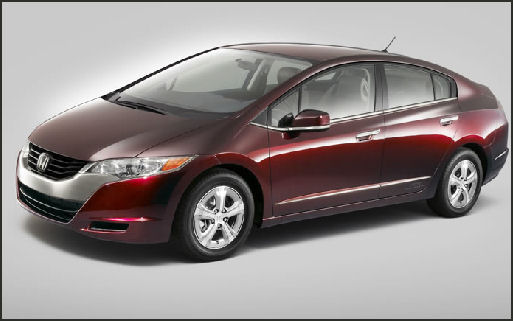
Honda Clarity
The FCX runs on hydrogen and electricity and produces no global warming gases. It is two times more energy efficient than a gas-electric hybrid and has three motors: one for the front wheels and one each for the back wheels. It makes a whooshing sound when it is turned on as the hydrogen mixes with air. The electric engine is very quiet, sounding like a golf cart at low speed and perhaps a quiet aircraft engine when it picks up speed. The only exhaust is water.
Describing what it is like to drive the FCX Clarity, Christian Caryl wrote in Newsweek, “Slip behind the wheel and press the pedal, and the car accelerates with satisfying punch. But after a few minutes of cruising, you’ll notice that something’s missing. The only engine noise is a whir so faint that you can actually hear the tires swishing along the asphalt.”
The biggest problem with hydrogen cell cars is getting a hold of the hydrogen. Gas stations with hydrogen have opened in Irvine, Torrence and Santa Monica, California. Honda is developing a home fuel station that uses a homeowners natural gas supply and solar energy to produce hydrogen. Such a system would negate the need to refuel at a station.
In 2009, Honda plans to introduce a fuel cell sports car with a top speed of 160kph and a traveling range of 570 kilometers. Honda hopes to start mass production of fuel cell cars in 2015.
In August 2005, Honda, GM and BMW agreed to tie up on fuel cell R&D. The three firms aim to standardized fuel nozzles, filler necks and other relayed components to establish a safe hydrogen supply system. Hydrogen os kept at -250 C. If it leaks it can be very dangerous.
Honda also makes solar cells and produces a clean and efficient diesel engine. In 2009, Honda plans to introduce a diesel car that meets California’s strict diesel exhaust standards.
Honda plans to enter the electric vehicle market in the mid 2010s.
Toyota Fuel Cell Cars
In 2001, General Motors, Toyota and Exxon announced a partnerships to jointly develop fuel cell technology using a gasoline-derived hydrogen as opposed to the methanol-derived hydrogen fuel cells being promoted by DaimlerChrysler. The advantage with the General Motors, Toyota and Exxon alliance is that it can utilize existing Exxon filling station infrastructure.
Toyota has said that it hopes to begin commercial production of fuel-cell vehicles by 2015. The car initially is expected to sell for about $50,000, the same as its production costs. Toyota has developed a fuel cell hybrid called the FCHV that has a maximum cruising range of 830 kilometers. It was made available for leasing in Japan in 2008. Toyota entered the fuel cell market by leasing two modified Highlander SUVs to the University of California and opening up six hydrogen fuel stations. Toyota also makes vehicles that run on compressed natural gas (CNG) and liquified petroleum gas (LPG).
Nissan Alternative Cars
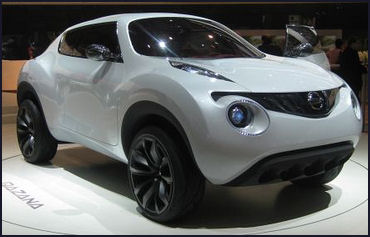
Nissan concept car Nissan was late in developing hybrid cars because it CEO Carlos Ghosn believed they were money losers. Nissan released a hybrid Altima in 2006 with Toyota parts and technology. The same year it ended its hybrid tie-up with Toyota so it could develop its own hybrid technology — using lithium-ion batters rather the nickel-hydrogen ones used by Toyota and Honda — available on vehicles sold in 2010.
Nissan has developed what it calls a “collision-free” vehicle. It has “back-up collision” sensors which detect objects and apply the brakes when an object is directed and “side collision prevention” which activates a yawing mechanism if a vehicle is detected to close behind during a lane change. Nissan has also developed a concept car with a robotic head on the dashboard that can sense a driver’s facial expressions to determine mod and conduct an appropriate conversation.
Nissan and Renault have developed fuel cell cars using the Toyota, GM and Exxon standard. In 2003, Nissan began leasing X-Trail fuel-cell with a lithium-ion battery.
Other Alternative Cars in Japan
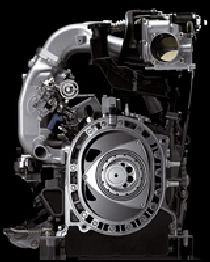
Mazda hydrogen rotary engine In 2009, Fuji Heavy Industries began selling the two-seat R1 electric vehicle developed with Tokyo Electric Power Co. The vehicle can has a lithium-ion battery and can travel 80 kilometers after the batteries are charged for eight hours using a household wall socket. The electricity costs are about ¥2 per kilometer. The vehicle will sell for between ¥2 million and ¥3 million.
In September 2009 Honda unveiled an intriguing “personal mobility device” called the U3-X that was essentially a unicycle that went whatever direction the driver wanted’sideways and as well as forward and backward — by leaning and was difficult to fall of from. Weighing about 10 kilograms and powered by an electric charge that lasts for about an hour, the devise stands upright on its own and can used like a stool. It unusual stability is made possible by many tiny motor-controlled wheels packed inside the bigger wheel, The “Us” in U3-X-U stands for “unicycle” and “universal.” Honda has not announced any sales plans for the device or how much it will cost. Among the proposals are for it to be used by the elderly people or factory workers.
Mitsubishi makes direct-gasoline injected motors and has developed the sleek fuel-cell-powered Space Line with DaimlerChrysler.
Suzuki is developing a fuel cell car with GM. Road tests began in 2008. See Suzuki
In 2008, Komatsu began selling the worlds first hybrid heavy machinery — a 20-ton excavator.
Image Sources: 1) 10) Osaka Gas 2) Sanyo 3) 5) 6) 7) Toyota 4) Mitsubishi 8) 9) 11) Honda 12) Nissan 13 Mazda
Text Sources: New York Times, Washington Post, Los Angeles Times, Daily Yomiuri, Times of London, Japan National Tourist Organization (JNTO), National Geographic, The New Yorker, Time, Newsweek, Reuters, AP, Lonely Planet Guides, Compton’s Encyclopedia and various books and other publications.
Last updated July 2011
